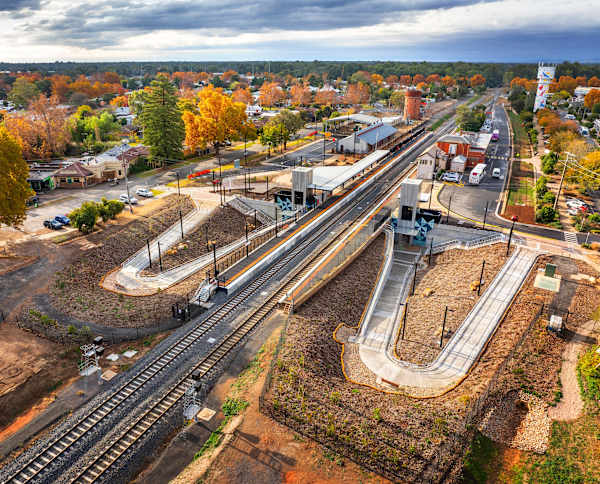THE $70 million Inland Rail project at Wangaratta was officially opened with dignitaries marking the historic occasion on-site on Tuesday.
Planning and works have been five years in the making, and 48 Wangaratta businesses have benefited from $18m in employment during the construction phase, including 488 local people living in the Wangaratta district.
It was part of tranche one Inland Rail Beveridge to Albury, which cost $300 million, with $161 million of this spent on employment - including $10.5m with First Nations’ businesses - and overall about 1500 workers were locals.
Minister for Infrastructure, Transport and Regional Development Catherine King opened the Wangaratta Inland Rail project with the cutting of a ribbon, while a local choir sang an entertaining song titled 'Wangaratta Choo Choo', written by Jim McKean, to mark the milestone event.
“As part of getting double stacked freight trains onto Inland Rail we’ve also been able to upgrade this rail precinct in Wangaratta,” Ms King said.
Latest Stories
“There have been so many local people from the surrounding district employed on this project.
“The fact that we’ve seen local electricians, plumbers, construction workers building this precinct here is a great testament to the skills and Inland Rail contributing to the skills growth in this community.”

Ms King highlighted the high standard of disability access now at the Wangaratta Railway Station, as the previous set-up was built more than 100 years ago.
“It’s about making sure people can access the platforms and trains, and it's the basic human right of being able to go to the toilet,” she said.
Ms King said the whole Inland Rail project will be more than 1600km of track from Melbourne to Brisbane, taking freight off the nation’s roads with 70 per cent of the freight task to come onto Inland Rail once complete.
"To make sure Inland Rail is viable compared to road they need to be able to deliver the volume that road can at the time that road can," she said.
Inland Rail CEO Nick Miller said the precinct has been “a long, tough journey for the teams” and the finished result was outstanding, with Wangaratta an important part of the overall milestone.
“We’ve had a deliberate strategy to involve local businesses for this project and our construction partner McConnell Dowell put in an enormous effort with over 1600 people working on this project since its commencement," Mr Miller said.
“We relocated the western track, and the dive was removed and a lot of that work has to happen during possessions.
“The possessions are around 60-100 hours and a very intensive period of activity goes on in construction during those possessions.
“Brown fields projects do take longer that green fields projects."
Mr Miller said Inland Rail is a critically important project for the nation’s economy and the regions.
“If we think about the trains that run on Inland Rail, they are 1.8km long, double-stacked and each one of those trains will take 110 b-doubles off the road,” he said.
“It’s good for safety, sustainability and the economy in terms of having an efficient connection between Brisbane and Melbourne and the inland ports."
But while Inland Rail will take the place of hundreds of b-double trucks, Mr Miller indicated truck freight would still be required.
“Ultimately, if you look at the freight task between now and 2040 to 2050, the freight task is expected to grow over 26 per cent, so the reality is the secret here is not just about road and not just about rail, it’s a combination as our economy grows and the volume of our goods increases," Mr Miller said.
Indi Independent MP Helen Haines said the completion and opening of the project made it a good day for Wangaratta.
“From this day forward we see an improvement to our town – better parking, better disability access, better and safer access to the trains and a new precinct that connects the health services to the main part of our city,” she said.
“We’ve seen a net migration out of the cities to Wangaratta after Covid and we need to make sure that our infrastructure matches the population growth.
“What I’d like to see now is improved engagement, improved services when it comes to the numbers of trains available on our timetable and additional carriages.
“We’ve seen the numbers of people using the train increase with the changes in fares and I think we’re only going to see more and more growth as people come and realise what a fantastic facility this is.”
The Wangaratta Railway Station project works included the filling of the former dive track and platform on the Norton Street side, removal of two pedestrian bridges, building of a new west track and platform for northbound traffic, installation of accessibility infrastructure such as lifts, pedestrian ramps and amenities, and new carparking on the east and west sides of the station.
As part of the project the tracks were lowered 2.8 metres under the Green Street bridge to allow for double-stacked freight trains, and the old bridge was replaced, complete with road works and barriers.


















